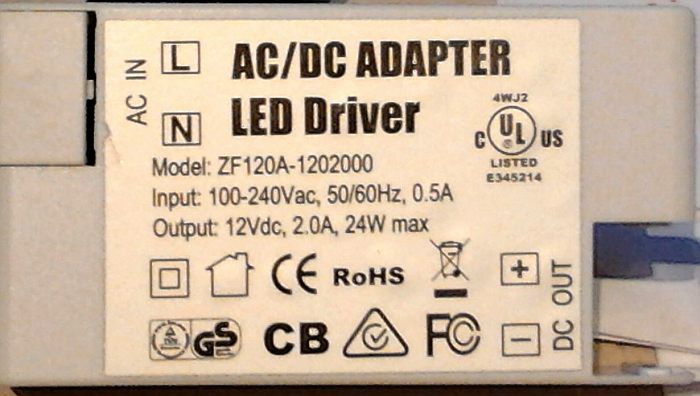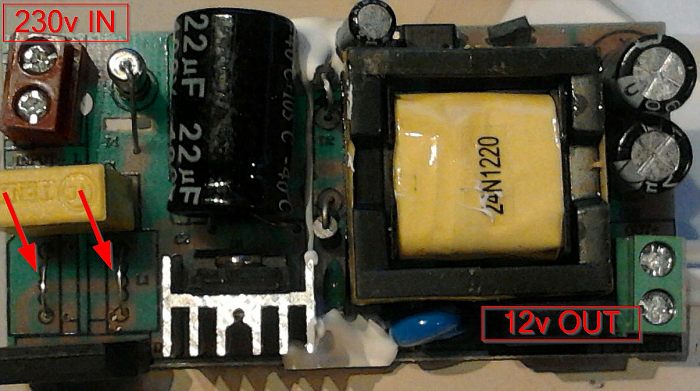 |
|
Electronic ballast and filter. Note the braid from filter to chassis 'ground' |
|
The RF filter used, I found it in my junk box .... |
Some months ago I replaced one 150w halogen floodlight around the house by a 20w LED type, being bored by swapping regularly the bulb and eager to introduce 'innovating technology' and save on the electricity bill.
Around same time, I noticed at night from time to time heavy QRM (radio interference = EMI), wide spread on HF bands, but in particular on the 40m band, killing the reception of weak stations.... but did not make the relation between the new floodlight and the QRM !
Purely by coincidence, I discovered later that the interference was effectively caused by the new floodlight ! This much to my surprise, the floodlight being at about 50m distance from my antenna....
Now, as we all know, these power LEDS are operating on low DC voltage, and the 230v AC mains is converted to this voltage by an 'electronic ballast', in fact a switching regulator. As this switching is performed at high frequency, a lot of harmonics and rubbish is generated ...
I attempted to reduce this by inserting several ferrite clamp-on chokes on the mains supply, close to the light, with no effect at all. Winding the mains power cord on a ferrite rod and inserting a capacitor between AC and DC leads had as well no effect ... quite frustrating !
As meanwhile the infrared sensor of the floodlight was no longer operating in a reliable manner, I had to change the complete thing, hoping that with another brand of lamp the troubles would disappear... NOT TRUE ! Same problem: no 40m operation when the floodlight is on !
So had to investigate this further ... With the aid of a spectrum analyser close to the floodlight, I could indeed detect wideband QRM, and in particular very nasty peaks from 6 to 8 Mhz.
The only solution which proved to be very effective, was the insertion of an EMC/EMI mains filter in the AC supply leads ! QRM on HF now completely gone ;o)
See pictures below. The challenge is off course to find space for the filter in the casing of the floodlight. When inserting the filter, take care to provide a good RF path to ground (=casing), like here with some braid (=outer shielding from RG213 coax cable for example). if there is no more space inside the housing, the filter can be mounted outside, in a watertight junction box, as long as the leads between floodlight and filter are kept short.
Later on, I did the same operation on 2x 50w LED flood lights (equivalent to 500w halogen) located close to my antenna - with exactly same good results. All filters were found in my junk-box, scrapped from old equipments, so I am not able to recommend a particular type, but guess that all will perform well - especially these with a double section (2x 2 inductances + capacitors). In general these EMI filters (e.g. made by SCHAFFNER http://schaffner.com ) reject frequencies around 10 MHz by at least 50 dB. See the schematic printed on filter case to determine the filter type.
Good luck with solving your interference troubles !
 |
|
Electronic ballast and filter. Note the braid from filter to chassis 'ground' |
|
The RF filter used, I found it in my junk box .... |
Had to repair the 'electronic ballast' of a LED light chain in the kitchen. As the original one 230v / 15w @ 12v DC had heated up till it became defective, upgraded to a 24w version which I purchased on Ebay (13 €, a real bargain) Again, the 20m HF band full of QRM !

By curiosity, I opened up the device, in order to check if some measures could be taken.

Indeed, there are provisions for some components to reduce EMI, but much to my surprise, they replaced in China 2 inductors (intended to block RF noise) by simple wire bridges ! Well, a piece of wire is also an inductor... maybe to block harmonics in the GHz range ?

I really believe that these components were installed during EMI testing of device (if these have effectively been done ?) and later omitted during production in order to cut costs !
I replaced the 2 wire bridges with some small ferrite toroids into which several windings were placed, the noise on my receiver dropped with about 30 dB (1.000 times less !), but still too high for clean reception. Later, the power supply was replaced with a small switched mode PS made by Phoenix Contact (33 €) - this one produces no QRM whatsoever = QUALITY !